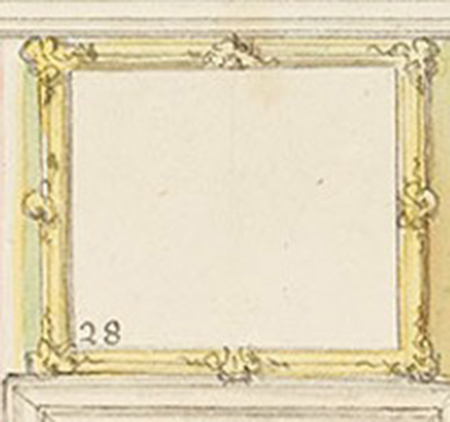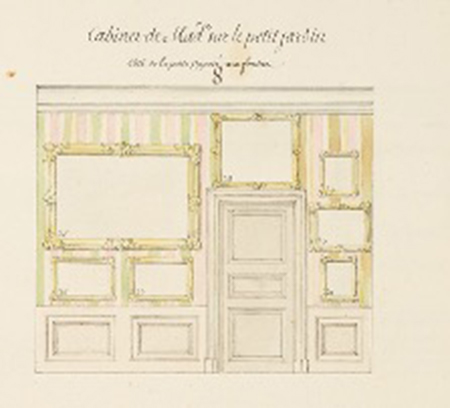
- Home Page
- Accepted
Paintings & Copies - Doubtful
Attributions - Doubtful Textual References
- Alternative
Titles - Collectors &
Museums - Bibliography
- Search Abecedario
- Watteau &
His Circle
Le Docteur Baloit de la comédie italienne
April 2020

Presumed lost
Oil on canvas
89.1 x 75.6 cm (or 72.9 x 91.8 cm)
ALTERNATIVE TITLES
Le Docteur de la comédie italienne
PROVENANCE
Paris, with Jean de Jullienne (1686-1766; director of a tapestry factory). This painting is listed in the catalogue of his collection created by 1757, now in the collection of the Morgan Library & Museum, New York, pp. 29-30. It is listed in the index of artists under “Watteau (Antoine)” and is described as “le Docteur Baloir de la comédie italienne de 33o . . . sur 28o de haut.” The painting (actually only the frame) is shown in the “Cabinet de Mme “ opening onto a small garden,” on the wall opposite the windows and positioned over a door. The frame confirms that the picture was a horizontal rectangle. Jullienne no longer owned the painting by the time of the March 1767 sale of his collection.
Paris, collection of Jean-Baptiste Guillaume de Gevigney (1729-1802; abbé). His sale, Paris, May 18ff, 1769, lot 208: ‘Un Tableau peint sur toile par Vateau représentant le Docteur de la Comédie Italienne dans un fond de Paysage, dans sa bordure dorée, h. 27, l. 34. Il vient du Cabinet de feu M. de Julienne qui l’a fait graver.” An annotated copy of the sale catalogue in the Bibliothèque Doucet is marked “24 1 [livres]” and “Prusse” [i.e., roi de Prusse].”
Germany(?)
SELECT BIBLIOGRAPHY
Hédouin, “Watteau” (1845), cat. 42.
Hédouin, Mosaïque (1856), cat. 42.
Goncourt, L’Art au XVIIIème siècle (1860), 56.
Goncourt, Catalogue raisonné (1875), cat. 73.
Dacier, Vuaflart, and Hérold, Jean de Jullienne et les graveurs (1921-29), 2: 58, 67, 93, 97, 102, 121, 132; 3: cat. 156.
Réau, “Watteau” (1928), cat. 59.
Adhémar, Watteau (1950), cat. 12.
Macchia and Montagni, L’opera completa di Watteau (1968), cat. 12.
Ferré, Watteau (1972), cat. B11.
Roland Michel, Watteau (1981), cat. 88.
Roland Michel, Watteau (1984), 156, 265-66, 269, 272.
Washington, Paris, Berlin, Watteau 1684-1721 (1984), 514.
Costa de Beauregard, Journal de voyage (2013), 120 n. 463.
REMARKS
The histories of this painting and Le Docteur have been confounded, as though they were one and the same picture. This was only natural since they both depict the same commedia dell’arte character and both were owned by Jean de Jullienne. However, the format of this painting was a horizontal rectangle whereas the other picture, engraved by Audran, was vertical in format. This second picture is catalogued here as Le Docteur. Also the measurements of the two works differ; the exact sizes vary from one account to the other but, nonetheless, Le Docteur Baloit de la comédie italienne was consistently larger.
The conflation of the paintings extends as far back as the 1769 Gevigney sale catalogue, which states that the painting “vient du Cabinet de feu M. de Julienne qui l’a fait graver.” Jullienne engraved only the smaller, vertical work. More recently, Roland Michel, troubled by the conflicting accounts, asked whether there might have been two separate works but then dismissed her own notion.

Anonymous French draftsman, Diagram of the wall opposite the windows in the Cabinet de Mme. de Jullienne (detail). New York, Morgan Library & Museum.
The manuscript catalogue of the Jullienne collection is illustrated with a view of the painting in situ on the walls. However, the manuscript is largely incomplete and although the frames are shown in place, most of the paintings are not depicted. Unfortunately, Le Docteur Baloit de la comédie italienne is one of the paintings left blank. Those critics who state the painting is depicted in the Morgan Library manuscript have evidently not seen the manuscript. What the drawing confirms is that the painting was a horizontal rectangle, just as it is listed twice in the manuscript.
The fate of the picture owned by Julienne and Gevigney is not known. When it was sold in 1769, it was apparently bought by an agent acting on behalf of the Prussian court, the same agent who bought several lots in that sale, including a Rest on the Fight into Egypt by Sebastian Bourdon (lot 168); a portrait of a child by Alexis Grimou (lot 222); two mythological subjects by Colin de Vermont (lot 230); a scene with highway robbers by Adam van der Meulen (lot 196); and two works depicting animals (lots 116 and 123). However, Le Docteur does not appear in any of the inventories of the German royal household.